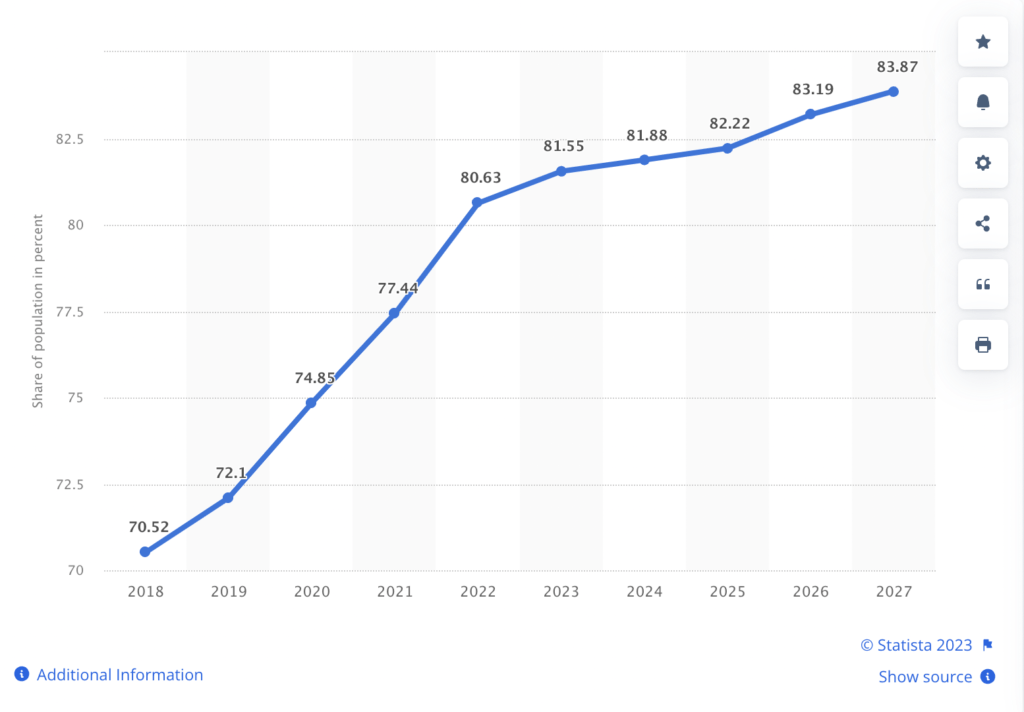Germany’s digital landscape is evolving at breakneck speed, with e-commerce emerging as a dominant player. As the digital world expands, e-commerce’s reach extends, penetrating deeper into consumers’ lives and businesses’ operations. The forecast for the next few years paints a promising picture for e-commerce in Germany, with a steady increase in user penetration expected from 2023 to 2027.
The Forecasted Growth: A Testament to Digital Shopping
The forecasted growth of e-commerce in Germany is a testament to the increasing reliance on digital platforms for shopping. The user penetration in the e-commerce market in Germany is set to rise by 2.3 percentage points between 2023 and 2027. That’s not just a number; it’s a sign of the times. It’s a reflection of how integral e-commerce has become to our daily lives, and how it’s set to become even more so in the years to come.

According to this forecast in 2027, the user penetration will have increased for the fourth consecutive year to 83.87 percent.
The Current Landscape: A Steady Upward Trajectory
The current landscape of e-commerce in Germany is already impressive. The user penetration rate has been on an upward trajectory, with more and more consumers turning to online platforms for their shopping needs. This trend isn’t just a flash in the pan; it’s been a consistent pattern over the past few years. It’s a clear indication of the growing acceptance and adoption of e-commerce among consumers in Germany.
The Implications: A Win-Win Situation
The implications of this increasing e-commerce penetration are indeed far-reaching, affecting both businesses and consumers in significant ways.
For Businesses: A Larger Digital Audience and a Need for Adaptation
For businesses, the rise in e-commerce penetration signifies a larger digital audience to cater to. It’s not just about having more potential customers; it’s about having a wider demographic reach. With e-commerce, businesses can reach consumers beyond their geographical boundaries, opening up opportunities for increased sales and growth.
However, this also comes with the need for businesses to adapt to changing shopping behaviors. As more consumers turn to online shopping, businesses must ensure their digital presence is strong and their e-commerce platforms are user-friendly. They need to invest in robust e-commerce platforms, efficient logistics, and effective digital marketing strategies.
Businesses must also understand that e-commerce is not just about transactions; it’s about building relationships with customers. They need to provide excellent customer service, personalized shopping experiences, and secure payment options to gain and retain customers’ trust.
For Consumers: More Convenience, More Choice, and the Power to Shop from Home
For consumers, the increasing e-commerce penetration means more convenience and more choice. They can shop anytime, anywhere, without the constraints of store hours or location. Whether they’re at home, at work, or on the go, consumers can browse through a wide array of products with just a few clicks.
E-commerce provides consumers with a wealth of choices. They can compare products, read reviews, and make informed decisions without the pressure of salespeople. They can also discover new brands and products that may not be available in their local stores.
Furthermore, e-commerce allows consumers to shop from the comfort of their homes. This has become particularly relevant in the wake of the COVID-19 pandemic, where safety concerns have led more people to opt for online shopping.
A Win-Win Situation Driving the Growth of E-commerce in Germany
In essence, the rise of e-commerce in Germany is a win-win situation. Businesses get to reach a larger audience and tap into the growing digital market, while consumers enjoy the convenience, choice, and power that e-commerce offers. This mutual benefit is driving the growth of e-commerce in Germany, and it’s a trend that’s set to continue in the coming years.
Other Key Market Indicators: A Comprehensive Picture
But user penetration isn’t the only indicator of the health of the e-commerce market. Other key market indicators, such as revenue and the number of users, also provide valuable insights into the state of e-commerce in Germany. These indicators paint a comprehensive picture of the market, helping businesses and consumers alike understand the dynamics of e-commerce in Germany.
The Future: Bright and Promising
In conclusion, the future of e-commerce in Germany looks bright. The forecasted increase in user penetration, coupled with the current upward trend, paints a promising picture for the years to come. As e-commerce continues to evolve and grow, it’s set to become an even more integral part of our lives.
The Takeaway: Embrace the Digital Revolution
So, what’s the takeaway from all this? E-commerce in Germany is on the rise, and it’s showing no signs of slowing down. Whether you’re a business looking to tap into the digital market, or a consumer seeking convenience and choice, the message is clear: e-commerce is the way forward. So, let’s embrace the digital revolution and ride the wave of e-commerce. After all, the future is digital, and the future is here.
***
Don’t miss a chance to be up to date with the e-commerce trends and news! Become a member of the extraordinary audience.



